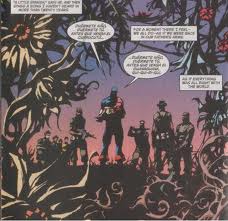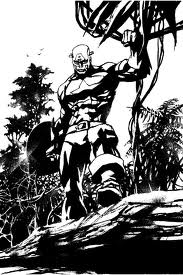Comics /
Back Issues
Backissue Retrospective: Darko Macan's Captain America
By Dan Horn
June 1, 2012 - 13:07
 |
After the cataclysmic tragedy of 9/11, there was perhaps no other pop
culture medium that was more unlikely, yet more successful, in capturing
national and regional sentiments than comic books. From the intimate
and heartrending Amazing Spider-Man #36 to the utterly confused, yet
unrelenting, knee-jerk nationalism of John Ney Rieber and John
Cassaday's Captain America relaunch, the American pulse had been tapped,
for better and for worse, and was transferred directly into sequential
narratives for a kind of historical preservation. Comics constructed a
mythic parallel to the haunting and corporeal photographs, news clips,
and physical and psychological residues left by September 11, 2001. The
reaction of Marvel Comics characters is perhaps most incisive, as the
majority of that fictional universe resides in the very tangible New
York City. The resonating impact of the catastrophic attacks on American
soil were not only seen directly on the illustrated page, however.
Humor books, like Codename Knockout, voluntarily ceased publication not
long after September 2001. In this new era of terror, there didn't seem
to be much room left for light-hearted fare or kitsch. Other books were
delayed or cancelled in the interest of respecting those killed in New
York, Pennsylvania, and Virginia. Like the horror and sci-fi comics of
the 50's, which keenly reflected the Depression- and war-fatigued
nation's fears of an imminent nuclear Armageddon, the comics of the
immediately post-9/11 US adopted a decidedly somber tone, shot through
with anti-terror and appropriately alarmist gravitas; and then, all at
once, comics portrayed a nation coalescing in support of everyday
heroes: firefighters, police officers, soldiers and marines and sailors
and airmen. Unfortunately, some comics also captured the xeno- and
Islamophobic fallout of the tragedy, and that ignorance lingers even
today through the works of creators like Frank Miller; and where we once
thought we'd seen the ugliest and most uninformed anti-immigration
rhetoric in decades past there was a neon sign flashing, "You ain't seen
nothing yet." We became inspired by asinine country music ballads and
dutifully snatched up Dollar Store American flags (often made in China,
ironically). We vocally supported our troops, if not the mission, but
only so long as we could remain blissfully dismissive of a cohesive
national war effort. And soon even that spoken pretense of loyalty and
patronage faded away. At the cost of 3,000 innocent lives, Americans
became aware of themselves at their most beautiful and, conversely,
their most grotesque; and it seemed an overarching vocational interest
of the comic book community to document in great detail and immediacy
the nuances of this new American era, but not as mere observers. Rather,
the comic book community was just as much a group of active
participants as a collective of archivists. So, where did a miniseries
like Captain America: Dead Men Running, which saw an iconic
star-spangled hero speaking Spanish eloquently and battling rogue US
soldiers, fit into this post-postmodern age of neopuritanical nativism
and posited ultra-nationalism?
 |
To answer that question, one is forced to assess Dead Men Running in
relation to the circumstances surrounding the change of an epoch.
Captain America: Dead Men Running, with its artful narration and Danijel Zezelj's rough,
inky, symbolic illustrations, was not ahead of its time. It was an almost unilaterally overlooked relic
of pre-9/11 cynicism and pessimism. Writer Darko Macan asserted a
quaint, Mamet-like predilection for incessant name reaffirmation; his
was a simple morality tale that struggled to find its audience, further
constrained by PG-13 sensibilities in lieu of bleak subject matter that
wanted so badly to crossover into uninhibited realism; his series' run
length was also perhaps too short to be collected in future trade
formats; but perhaps what really doomed the three-issue miniseries to
obscurity was its subtle subversion.
The first issue opens with a squad of American commandos radioing for
extraction from the dense, hostile jungles of Columbia. In tow are
several Columbian children, presumably liberated by the Americans. As an
American plane passes overhead, the commandos' jubilation turns to
bewildered disappointment as only a lone man can be seen parachuting
from the aircraft into the jungle canopy. The Americans, children
corralled and following, trudge deeper into the vegetation, certain
their one-man rescue party is already dead, or if not dead then useless
anyway.
When Columbian guerillas tracking the Americans are in position to
ambush the squad, Captain America, the lone parachuter, also emerges
from the undergrowth, just in time to intervene. After the scuffle, Cap
takes time to reassure the reticent Columbian children of their safety.
He puts one girl at ease with a traditional lullaby in Spanish.
This is the first instance that made me raise an eyebrow. I was
immediately reminded of California's prop 187, introduced in the
mid-90's, and memories came flooding in of all of those disgusting
political ads that came with it: Mexicans portrayed as scurrying over
the border like cockroaches in black and white to an ominous soundtrack.
In 2001, we hadn't come any farther as far as civil rights for Chicanos
and Latinos. In 2000, a North Carolina medical study* found that many of
the state's Chicano agricultural laborers were being kept in work camps
which were practically trash heaps, breeding anthrax in stagnant pools
of water and leaving the workers exposed to the elements in the brutally
humid summers and frigid winters. The study also concluded that over
50% of these workers made less than $7500 annually per family unit, and exposure
to toxins in pesticides, skin contact with poisonous plants like
tobacco, long days laboring in the unrelenting sun, and unregulated and
unsafe work environments made agriculture the second deadliest
occupation in America. But, most Americans didn't care about the
inhumane conditions these farm workers were (and still are) subjected
to. Those conditions and the sparse wages allotted to the workers meant
slowed inflation on agricultural commodities. Chicanos are, and always
have been, since the conquest of Aztlan in the 16th Century and later
the absorption of Mexican land and nationals in 1848, an internal labor
colony of Anglo-Americans.
 |
It was only when unemployment rates were up, as they are now, that
American nationalists would take notice of undocumented laborers, and it
wasn't to thank them for their indentured servitude, their slowing of
commodities inflation, or their massive contributions to Social Security
and Medicare without the ability to collect from those same public
services. No, it was to blame "Hispanics" for taking American jobs,
though we know in hindsight that even unemployed American citizens were
largely unwilling to subject themselves to hard labor; it was to blame
them for crime rates, while overlooking obvious contributing factors
like lack of healthcare, ethnic hatred, and the looming threat of
deportation which kept undocumented Chicanos from reporting violent crimes within
their own communities and from admitting themselves or each other into
hospitals after being victimized; it was to rebuke schools involved with
bilingual education and dual immersion programs. The stance against
bilingual education in many states is one that has bankrupted our
culture and our defense department in the long run, but it wasn't that
long ago that we endured the insufferable rhetoric of our far-right in
regards to the inferiority of the Spanish language in comparison to
English.
And that's a line that's been used as far back as I can recall. I
remember family gatherings as a child where I'd overhear all manner of
casual, derogatory epithets hurled at "dirty Mexicans" and their somehow
inherently criminal language. And yet here is Captain America, the
embodiment of US nationalism, singing eloquently in Spanish and cradling
a little Latina in his red, white, and blue arms. It's a stirring
illustration, however simple and however easily it may be overlooked.
What makes a patriot, then: a staunch and uncompromising defense of
America's Anglo and puritanical roots, or the modern sensibilities that
will secure the nation a favorable global position in the future? Macan
seems to have an idea pertinent to that question, making the incarnate
patriot a cultured and compassionate figure, an idealized image of
nearly religious proportions. Perhaps Macan's Captain America is a bit
of both, a glimmer of modernity under a gaudy sheath of American
convention.
When the squad comes under attack once more, Cap observes the reaction
of the Columbian children. They recognize the Columbian attackers and
call out to them. Cap becomes suspicious of his squad, questioning
whether the children have actually been liberated. When the American
soldiers sedate Captain America and take him captive, it becomes clear
that the commandos have kidnapped the Columbian children to negotiate a
ransom with the Columbian cartel.
 |
This is where my eyebrow raises again. It is March of 2002, and nearly
every front door in my neighborhood bears a yellow ribbon, and jutting
out from every porch overhang is an American flag. Operation Enduring
Freedom, the military campaign in Afghanistan, and the Global War on
Terror had only begun months earlier, and the conflict and the sacrifice
of our service members was still fresh in our collective consciousness.
However, the unwavering support of our troops isn't the only thing put
on notice by Dead Men Running. September 11, 2001 had martyred
capitalism. As the World Trade Center towers crumbled into the streets
of New York City, Americans would come to defiantly rally behind the
economic principles for which the towers stood, the way of life and
commerce that the jihadists had so reviled.
Here, in Dead Men Running, our troops were reprobate opportunists. They
were the "vulture capitalists" spawned by decades of American greed.
They were not role models or heroes, but simply men who do anything to
make a living and even commanded to do so by a ranking military
official. By the time many of the soldiers in the squad realize that
they've erred from righteousness, it is already too late for them.
Macan's commentary on the American military and this kind of opportunism
is strikingly contradictory to period sentiments. Macan views the soldiers as victims of circumstances, motivated by an egress from poverty, not valiant and courageous volunteers. They perpetuate violent crime in a struggle to simply beat the system, and therefore perhaps the system is to blame.
Of course, this is all just a bit of bad timing on Marvel's
part. The series was most likely in development for some time, and then
further delayed by the events of September 11. However, releasing it a
few months later wasn't so much pouring salt in a wound as it was
something that simply did not ideologically compute and therefore was
largely ignored by comic book readership and the community. The
miniseries isn't without its own shortcomings, but it is groundbreaking
and cuts against the grain when considered side-by-side with its graphical
contemporaries. For that reason, Macan and Zezelj's Captain America:
Dead Men Running is a pop-culture oddity that deserves its place in the
annals of graphic history.
*
Hansen,
Eric, MD, et al. “Health Issues of Migrant and Seasonal Farmworkers.” Phsj.org. Phsj.org, n.d. Web. 23 Oct. 2011.
Last Updated: January 17, 2025 - 08:20




